
Entries from February 1, 2012 - February 29, 2012
Spring 2012 continuing education
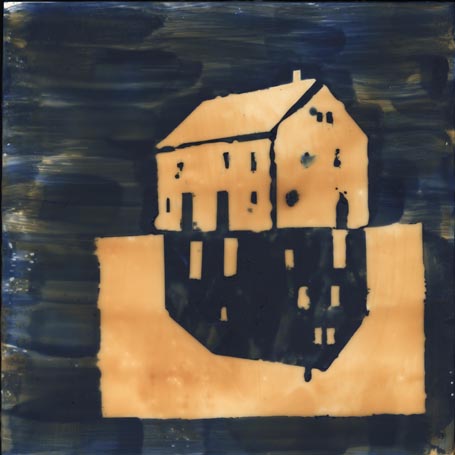 Blue house reflection, encaustic by Katie HutchisonRecommended New England course in encaustic painting
Blue house reflection, encaustic by Katie HutchisonRecommended New England course in encaustic painting
Last fall I took my first encaustic workshop. I chose a RISD Continuing Education weekend workshop much like the one RISD is offering this spring. It was great fun to experiment with a new-to-me, unpredictable medium. The encaustic painting I created above was my favorite by-product of the weekend. I say “by-product” because it’s the process of making that so engages me. It’s an added bonus when I’m happy with the resulting artwork.
Rhode Island School of Design Continuing Education
As a RISD alum, I am an unabashed fan of all things RISD. If you live within reasonable driving distance from Providence, I highly recommend you explore RISD’s continuing education offerings. If you live more than a reasonable driving distance from Providence, consider booking a weekend getaway. You’ll be glad you did.
Encaustic (Weekend Workshop)
Instructor: Taleen Batalian
Saturday and Sunday: April 21 and 22, 10am-4pm
Tuition: $220
Lab fee: $20
“Encaustic, an ancient technique used to create commemorative wax portraits in Roman and Egyptian art, is once again becoming a popular medium for artists. Also called hot wax painting, encaustic is the process of creating an image from molten beeswax colored with pigments and then applied to a surface -- either wood, masonite or canvas. The wax cools in minutes, enabling the application of many successive coats. Smoothing and scraping the wax, painting between each layer, and using heat to bind the layers creates a finish with a lustrous enamel-like appearance. By working from both invented imagery and direct observation, students of all skill levels are encouraged to experiment and allow their paintings to evolve as they reheat and rework surfaces until the desired effect is achieved.”
Class and schedule are subject to change so check program websites for updates.
Take a look at my continuing-education posts from previous seasons to get a sense of the many quality continuing education programs operating in the region. Enroll in a workshop, demonstration, or presentation on a lark, and get your creative juices flowing. Experience continuing-education bliss.
by Katie Hutchison for House Enthusiast
Design snapshot: Shingled swordfish at sea
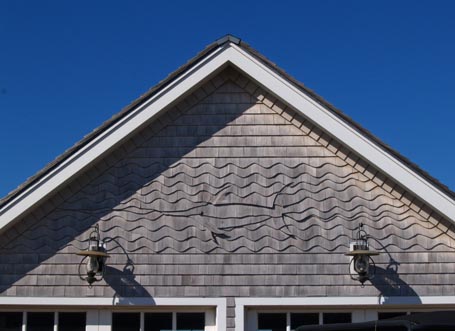 I know having favorites is generally frowned upon, but I happily admit that white-cedar shingles are my favorite building material. They’re versatile, durable, practical, and, in the right hands, can be shaped into graphic, artful, and/or fun creations. I like new, white-cedar shingles, the color of warm sand, and old, white-cedar shingles, weathered silver grey. I like them in all manner of courses: standard, alternating, scalloped, diamond-shaped, staggered, domed, chamfered, wavy, and pictorial; you name it.
I know having favorites is generally frowned upon, but I happily admit that white-cedar shingles are my favorite building material. They’re versatile, durable, practical, and, in the right hands, can be shaped into graphic, artful, and/or fun creations. I like new, white-cedar shingles, the color of warm sand, and old, white-cedar shingles, weathered silver grey. I like them in all manner of courses: standard, alternating, scalloped, diamond-shaped, staggered, domed, chamfered, wavy, and pictorial; you name it.
This shingled swordfish, in among shingled waves, edged by a shingled rake, adorns a modest garage which happens to border a beachfront property. I salute the inspired team who commissioned, designed, and created this scene, whoever they may be. Well done!
by Katie Hutchison for House Enthusiast
Web tour: Custom Home: Current housing trends
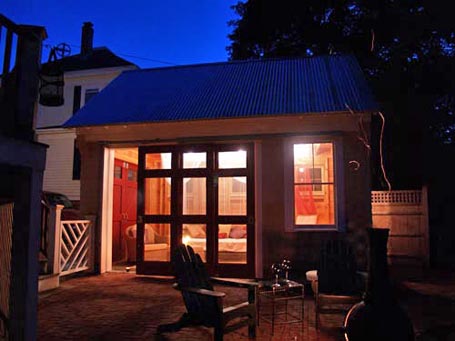 Take It Outside/A Room of One's Own (Manchester Garage/Garden Room by KHS)This week's Design Studio newsletter from Hanley Wood, LLC links to a Custom Home article which features current housing trends cited by architects and designers at this year's National Association of Home Builders International Builders Show. The story highlights 20 of the trends identified by 13 architects and designers in a 90-minute session at the Show.
Take It Outside/A Room of One's Own (Manchester Garage/Garden Room by KHS)This week's Design Studio newsletter from Hanley Wood, LLC links to a Custom Home article which features current housing trends cited by architects and designers at this year's National Association of Home Builders International Builders Show. The story highlights 20 of the trends identified by 13 architects and designers in a 90-minute session at the Show.
I found eight of Custom Home highlights to be particularly relevant. They are titled:
#7. Do the Right Thing.
#10. Gray Power
#11. Micro-'Hoods
#15. In the Pocket
#17. A Room of One's Own
#18. Take it Outside
#19. Dial Up the Density
#20. It Never Hurts to Ask
Follow this link to see the full Custom Home list and explanation in detail.
The architects and designers who participated in the housing trend idea-session are: Jerry Gloss, KGA Studio; Dawn Michele Evans, The Evans Group; Mike Woodley, Woodley Architecture Group; Monica Robertson, Hord Coplan Macht; Mary Dewalt, Mary Dewalt Design Group; Kathy Browning, Design Consultants; David O'Sullivan, O'Sullivan Architects; Todd Hallett, TK Design and Architecture; Mike Rosen, Martin Architectural Group, Cynthia Shonaiya, Hord Coplan Macht; Steve James, DTJ Architects; Scott Adams, Bassenian-Lagoni; Michael Ohara, KTGY Group.
by Katie Hutchison for House Enthusiast
Web tour: Old-House Journal: Sears kit houses
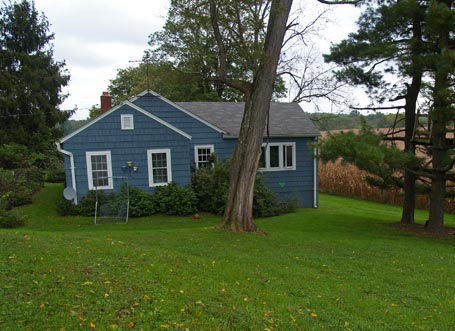 possible Sears kit house (with addition)We believed the original portion of this little cottage, where my friend and her family lived for years, to be a Sears, Roebuck and Company Modern Homes kit. Its walls and floors were all finished with wood or tile, not a smidge of plaster or Sheetrock -- except in the addition. I'm not sure if my fascination with the Sears kit houses of 1908-1940 was originally sparked by my friend's cottage or if the cottage merely reinforced my fascination. In either case, I continue to marvel at the genius of the Sears Modern Homes program, which endured until the Great Recession and pre-World War II building-material shortages took a devasting toll.
possible Sears kit house (with addition)We believed the original portion of this little cottage, where my friend and her family lived for years, to be a Sears, Roebuck and Company Modern Homes kit. Its walls and floors were all finished with wood or tile, not a smidge of plaster or Sheetrock -- except in the addition. I'm not sure if my fascination with the Sears kit houses of 1908-1940 was originally sparked by my friend's cottage or if the cottage merely reinforced my fascination. In either case, I continue to marvel at the genius of the Sears Modern Homes program, which endured until the Great Recession and pre-World War II building-material shortages took a devasting toll.
I was delighted to find an article in the May issue of Old-House Journal (on newsstands now) about the Sears, Roebuck kit houses of Hopewell, Virginia. I planned to link here to the story on the Old-House Journal website. However, I was disappointed to learn that the story is not yet available online, but, then, I made another discovery in the Old-House Journal article archives. There, I found "The Story on Sears" by Shirley Maxwell and James C. Massey. I'm not sure when the article was written, perhaps ages ago, but it's a great synopsis of how the Sears Modern Homes came to be, evolved, and, ultimately, ceased production.
The popularity of the kit-house concept tends to resurge every so often, as it did in the 2008 MOMA exhibit titled "Home Delivery, Fabricating the Modern Dwelling" which I wrote about here. It seems to me an idea that may again be gaining traction as we begin to emerge from the current recession and the dire lessons of living large and unsustainably. An updated, sustainable, human-scaled kit house, for the way people really live, may, once again, be in order.
by Katie Hutchison for House Enthusiast
Design snapshot: Distinctive Dutch door
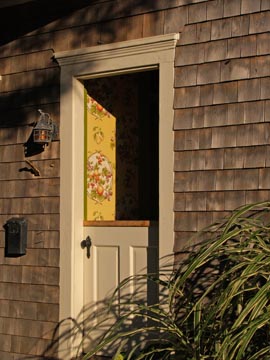 The Dutch door is one of architecture’s more versatile elements. It’s both door and window. We often associate Dutch doors with barns, as in the case of Mr. Ed. But a Dutch door is a great feature in a dwelling, too. It allows us to control access between spaces by closing the lower half, and to invite view and air flow by opening the upper half.
The Dutch door is one of architecture’s more versatile elements. It’s both door and window. We often associate Dutch doors with barns, as in the case of Mr. Ed. But a Dutch door is a great feature in a dwelling, too. It allows us to control access between spaces by closing the lower half, and to invite view and air flow by opening the upper half.
This Dutch door is a front entrance. The closed lower half signals that passersby aren’t encouraged to enter uninvited, but the open upper half communicates that the occupants, who are willing to share an enticing view of the entry hall’s elegant wallpaper, might be open to receiving guests.
Perhaps it’s the contrast of the stark, walled exterior and the hint of a vibrant, lively interior that drew my eye to this entry. Few other door types offer the opportunity for such a provocative juxtaposition. This one beautifully balances enticement and deterrent.
For more about Dutch doors read the Design snapshot: Entry duality, too.
by Katie Hutchison for House Enthusiast














